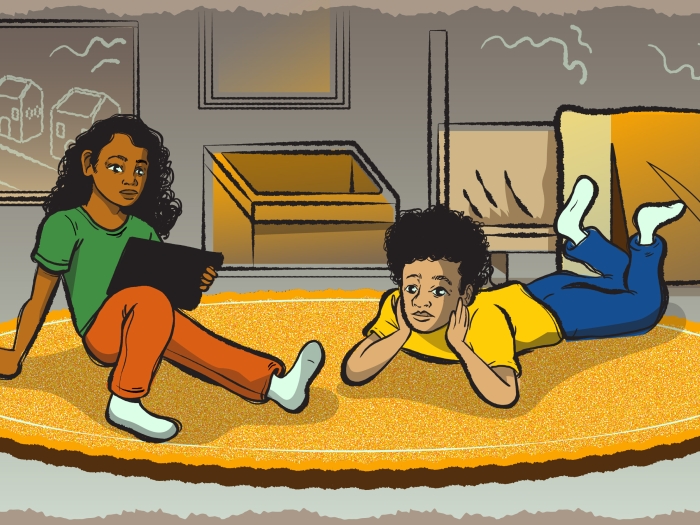Experts share tech savvy ways to better manage and control social media use on Instagram, TikTok and YouTube for youth, teens and kids.
9:57 AM
Author |
From limiting direct messages from strangers and changing comment settings to managing mentions, views, likes, and much more, specialists at C.S. Mott Children's Hospital created this step-by-step video for parents, guardians and teenagers and kids themselves to help set personal boundaries and improve mental health around various forms of social media platform use. Credit: Michigan Medicine
While young people often use social media to connect and interact with peers, many also recognize potentially unhealthy consequences that may come with its use.
A poll of a nationwide sample of youth aged 14-24 found that many people commonly altered social media settings or behavior to minimize negative impacts on their self-esteem, mood, relationships, emotional health and safety.
These strategies reported by youth, which ranged from setting time limits and unfollowing or blocking certain content to deleting apps altogether, can be harnessed, expanded and reflected back by health providers, experts say.
"We found that many young people were compelled to self-monitor their social media use because of their own emotional experiences with it," said Jane Harness, D.O., a child and adolescent psychiatrist at University of Michigan Health C.S. Mott Children's Hospital. "Often this meant changing settings to limit exposure to content that evoked negative feelings or other self-enforced boundaries."
But experts recognize that not everyone may be familiar with techniques to take advantage of social media settings.
"Those who are technologically savvy may already be using sophisticated strategies to modulate use, but others may be less aware of all the options available to them," said Tammy Chang, M.D., M.P.H., M.S., an adolescent health physician and health care researcher at Michigan Medicine. "Health providers can take a more active role to educate young people and their families about ways to reduce risks of having unhealthy experiences tied to social media."
But the social media space can be difficult to navigate, with every platform offering different settings, and some options are more well-known than others.
Parents of younger kids may also not be aware of settings that can help prevent children from being exposed to inappropriate content fed through channels, says Jenny Radesky, M.D., a developmental behavioral pediatrician at Mott who co-leads the American Academy of Pediatrics' new Center of Excellence on Social Media and Youth Mental Health.
"Kids are using social media at younger ages and it's important to know the plusses and minuses of different platforms -- to know which ones to avoid altogether, which ones to co-use with kids, and where to give kids more independence," Radesky said. "The goal is to help kids have healthy relationships with this technology, not feel reeled in or creeped out by it."
Experts share some of their top setting modifications for popular sites Instagram and TikTok that can help guide young people, caregivers, families and health providers.
Top social media setting tips for kids and teens
Instagram:
-
Under the "Privacy" tab in settings, there are the options to make the account a private account, limit unwanted interactions and block comments.
-
To report a post, click on the three dots in the upper right-hand corner of a post and then choose to report it. You may pick from a list of reasons, including spam, nudity or sexual activity, hate speech, bullying or harassment, false information, violence, scam, suicide or self-injury, eating disorders among others.
Limiting content exposure and time spent on the app
-
Users can hide "like" and "view" counts under the "privacy" tab in the settings, in the "posts" tab.
-
There are also options to choose which notifications are turned on and restrict time. This can be done under the "your activity" tab, in the "time spent" tab where there's an option to "set reminder to take breaks" and "set daily time limit."
-
To avoid undesirable content, users can go to the "explore" page, click on the post they don't want to see, click on the three dots in the upper right-hand corner and click "not interested." This will help the algorithm learn to reduce exposure to similar content.
-
There are also options to unfollow or mute accounts.
TikTok:
Reducing safety risks
-
Tik Tok guidelines state that they remove content, including video, audio, livestream, images, comments and text that violate their community guidelines and accounts involved in severe or repeated violations. Under certain circumstances, especially when there are safety concerns, accounts may also be reported to relevant legal authorities.
-
To report Tik Tok content, go to the specific video, press and hold on the video, select "report" and follow the instructions. There is also an option to use an online form to report videos, comments, direct messages, a sound, a hashtag or person.
-
By default, accounts for people under age 16 are set to private (you can approve or deny follower requests and only people you've approved can see your content.)
-
For ages 13-15, direct messaging isn't available and no one can duet/stitch with young teens' videos. For this age group, only "friends" can comment on videos, but there is an option to turn off the comments as well.
Those who are technologically savvy may already be using sophisticated strategies to modulate use, but others may be less aware of all the options available to them.Tammy Chang, M.D., M.P.H., M.S.
-
For ages 16-17, the default setting is that no one can direct message them, however it can be changed. The duet/stitch control is also automatically set to "friends" but can also be altered. For this age group, no one is blocked from commenting on their videos, but there is an option to turn comments off.
Limiting content exposure and time spent on the app
-
"Daily screen time" is a screen time management setting that sends users notifications when they reach their desired limit. This option is available under "profile." Users can click the three-line icon in the top right, then "settings and privacy," then "digital wellbeing" and then "daily screen time."
-
When the daily screen time limit is reached, users must enter a passcode if they want to keep using the app.
-
There is also an option to schedule "screen time breaks" which remind people to take a break from the app after a period of time. To do this, follow the same steps for setting screen time limits, but click "screen time breaks" instead.
-
When you reach your break time you will be notified but have the option to dismiss the notification, snooze to have another reminder in 10 minutes or edit the reminder.
-
You can also choose to receive weekly notifications about the amount of time spent in a given week and how it compares to the previous week
-
The site's dashboard can also be used to provide a summary of a user's time spent on TikTok from the digital wellbeing page.
-
Users can also influence which videos are curated for them in their stream. Recommended content is based on the user's expressed interests, video interactions and time spent watching certain videos. You can long-press a video and tap "not interested" to indicate that you don't care for a particular video. This will contribute to future recommendations in your "for you" feed.
-
You can also choose to hide videos from a particular creator.
YouTube:
For teen users
-
If you want YouTube to demand less of your attention, you can turn off notifications (under Settings) and turn off autoplay (a toggle button on the home screen).
-
If you don't like the trending and recommended videos, create your own library of subscriptions that you can intentionally follow and curate.
-
Flag videos by tapping the three dots under the video. If the video violates community guidelines it will be taken down, but if not taken down it may be restricted for younger users.
For parents of younger users
-
YouTube Kids has only content that has been designated as "Made For Kids" by the creator. Even though this still includes some "kidfluencers" that may exhibit behaviors parents don't want to encourage in their own kids and branded content, children are less likely to discover age-inappropriate content than the regular YouTube site.
-
Some school-aged children, however, still want to access certain types of content on the main YouTube channel not offered through the YouTube Kids app. To address this, YouTube has created a "supervised experiences" option where parents' accounts can be linked to kids' accounts and agreed-upon content filters and guardrails can be set up.
Live your healthiest life: Get tips from top experts weekly. Subscribe to the Michigan Health blog newsletter
Headlines from the frontlines: The power of scientific discovery harnessed and delivered to your inbox every week. Subscribe to the Michigan Health Lab blog newsletter
Like Podcasts? Add the Michigan Medicine News Break on Spotify, Apple Podcasts or anywhere you listen to podcasts.

Explore a variety of health care news & stories by visiting the Health Lab home page for more articles.

Department of Communication at Michigan Medicine
Want top health & research news weekly? Sign up for Health Lab’s newsletters today!





